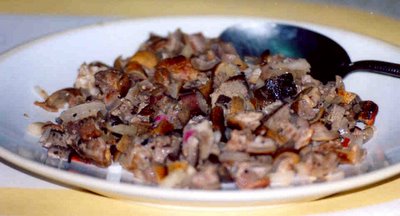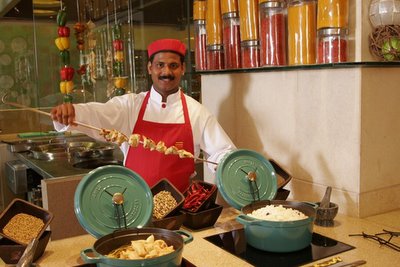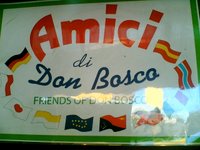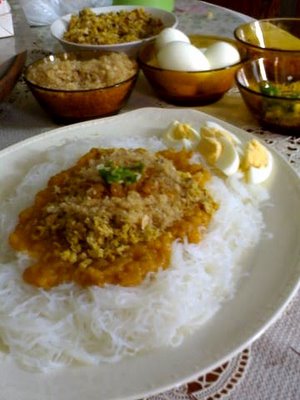A pig is favored because all the animal's parts, including the blood, can be cooked into different dishes. Pangasinan being surrounded by the South China Sea and criscrossed by rivers, streams and creeks, not to include the flooded ricefields during the rainy season, fresh fish and seafood are regular features in daily meals. So parties call for a taba ed bibil, literally "lard on one's lips," since fatty hogs are very much favored. Months before the scheduled party, a belek or fattening hog is procured for careful tending in anticipation of the richness it will eke out.
In small gatherings, or during the aforementioned pagatin, which is usually limited to family members and extended relatives, a smaller, "wilder" animal is preferred. Goats are mainstays of farmhouses in the barrios, led out to pasture and exercise every morning, and "come home" on their own every afternoon. The goats are either owned by those tending them, or tended for other families in kasamak* fashion. These goats are bred mainly for family reunions, particularly in remembrance of the death anniversary of a loved one, during All Souls Day, Christmas holidays, adult birthdays, and other excuses for a gathering around the table, including an excuse to drink up, with friends, with kindergarten classmates, and a thousand and one other reasons.
A goat has a lower fat content than a pig, requires low maintenance (just grass, sunshine and a little patch to run around), and gives less relative to the meat-bone ratio of a pig. So there's no worry of a goat meat overload, unlike when a pig is slaughtered and you'd have to contend with eating pork every meal for an entire week then worry about an impending heart attack.
But like how a pig slaughter and its cooking for a feast generates a spirit of community, killing a goat also brings to the fore the Filipino bayanihan spirit, whereby neighbors come along and help gratis. For of course, several people are needed to tie-up the goat, hold it for the fatal slash to the neck (may he rest in peace), for the ritual pulpog to burn the hair and skin, to carve the body, then to cook the various parts in spices.
Men commonly cook the goat meat and parts. I think this is just to continue the task of preparation from the slaughter to the table. Goat meat, too, is prized as pulutan, because it is gamey, in both senses of the word, thus requiring long cooking and a lot of flavoring ingredients and spices. Perhaps the men want to tailor the taste of the dishes to complement the Philippine national drink San Miguel pale pilsen or to several rounds of the more preferred (in price, not in taste) bilog or lapad (terms for the containers of the local gin).

 Of course, the goat dishes are not solely for pulutan, but mainly to eat with the family and relatives, sharing good times and catching up with one another's lives. They are meant to tighten the bond between blood relations by partaking of food at a table laden with family roots and tradition.
Of course, the goat dishes are not solely for pulutan, but mainly to eat with the family and relatives, sharing good times and catching up with one another's lives. They are meant to tighten the bond between blood relations by partaking of food at a table laden with family roots and tradition. *Kasamak (land tenant) is the Pangasinan term for a farmer who tends the landowner's real estate properties, with sharing of the proceeds of the land's output based on what was previously agreed upon and what is common practice, although nowadays it is determined by regulations set by the Department of Agriculture, especially if the property is under the Comprehensive Agrarian Reform Program or CARP.The kasamak can also tend for the landowner animals intended for selling for profit, or for future use, called iwi. If the animal is sold, sharing is about 50-50 after capital and tasa (advances made by the owner to the kasamak). If the animal is killed for meat, the owner gives the kasamak a patronage fee.
All these because the Philippines is still largely an agricultural country, with a feudal type set-up.
Related Posts
Kusina Nen Laki Digno
Igado
Poncia








 I tried to skip the excellent dishes I sampled last time, but then I saw that the classic smoked salmon in dill mustard was given a new twist - smoked salmon sat happily like a dewy tangerine rose on a polenta muffin, with a segment of grapefruit on top. A dollop of dill mustard made it look like the icing on a savory cupcake. Honestly, that was one inspired appetizer. The salmon was silky on top of the subtly grainy muffin, and the bitter-tart grapefruit rounded up the flavors of salty-creamy and slightly sweet. I had to go back. Again. And again.
I tried to skip the excellent dishes I sampled last time, but then I saw that the classic smoked salmon in dill mustard was given a new twist - smoked salmon sat happily like a dewy tangerine rose on a polenta muffin, with a segment of grapefruit on top. A dollop of dill mustard made it look like the icing on a savory cupcake. Honestly, that was one inspired appetizer. The salmon was silky on top of the subtly grainy muffin, and the bitter-tart grapefruit rounded up the flavors of salty-creamy and slightly sweet. I had to go back. Again. And again. 


 And I couldn't believe myself, but a little fiesta was going on right there at the Filipino section. There was a sweetish sinigang na sugpo (prawns in sour broth), chicken relleno, beef puchero, lechon, and wonder of wonders! kalderetang kambing! (goat meat stewed in tomato sauce). Right from my first forkfull, I realized I can never, ever brag again that only proper Pangasinenses (and maybe some Ilocanos, hehe) can cook a super-duper kalderetan kanding (as called in Pangasinan), the bony meats simmered slowly in tomatoes, potatoes, bell pepper, pickles and some secret ingredients. I was so astounded I wanted to meet the Filipino chef to ask if he was from Pangasinan (haha, still!).
And I couldn't believe myself, but a little fiesta was going on right there at the Filipino section. There was a sweetish sinigang na sugpo (prawns in sour broth), chicken relleno, beef puchero, lechon, and wonder of wonders! kalderetang kambing! (goat meat stewed in tomato sauce). Right from my first forkfull, I realized I can never, ever brag again that only proper Pangasinenses (and maybe some Ilocanos, hehe) can cook a super-duper kalderetan kanding (as called in Pangasinan), the bony meats simmered slowly in tomatoes, potatoes, bell pepper, pickles and some secret ingredients. I was so astounded I wanted to meet the Filipino chef to ask if he was from Pangasinan (haha, still!).  But on to dessert. That night the chocolate fountain had for its companion an orange-flavored milk fountain (not orange chocolate fountain - I don't think it's right to call anything un-chocolate as chocolate, like white chocolate, which doesn't contain a single minute microgram of cocoa, but is just milk fat), that played with my tastebuds, inducing a mild attack of sentimental indulgence on the sweets of my childhood.
But on to dessert. That night the chocolate fountain had for its companion an orange-flavored milk fountain (not orange chocolate fountain - I don't think it's right to call anything un-chocolate as chocolate, like white chocolate, which doesn't contain a single minute microgram of cocoa, but is just milk fat), that played with my tastebuds, inducing a mild attack of sentimental indulgence on the sweets of my childhood. 
 Kudos to HEAT for showcasing Filipino dishes in all their unadulterated splendor, without a hint of tweaking to suit foreign palates. Mabuhay kayo!
Kudos to HEAT for showcasing Filipino dishes in all their unadulterated splendor, without a hint of tweaking to suit foreign palates. Mabuhay kayo! 
 The buchi rolls are what are commonly sold in the provinces where they originated. I made mine ball-shaped like a Chinese buchi, flattening them out like how you flatten out a palitaw. This proved disastrous, though, because the balls were too thin to hold the filling together (or maybe I put in too much filling). The red kidney bean filling leached onto the coconut cream, turning it brownish, but the dessert turned out delicious, nonetheless, even though my friend and I forgot to mix sugar in the gata. So a note here: this is also good sugar-free, haha. And it can be eaten hot straight from the oven or cold straight from the ref the following day.
The buchi rolls are what are commonly sold in the provinces where they originated. I made mine ball-shaped like a Chinese buchi, flattening them out like how you flatten out a palitaw. This proved disastrous, though, because the balls were too thin to hold the filling together (or maybe I put in too much filling). The red kidney bean filling leached onto the coconut cream, turning it brownish, but the dessert turned out delicious, nonetheless, even though my friend and I forgot to mix sugar in the gata. So a note here: this is also good sugar-free, haha. And it can be eaten hot straight from the oven or cold straight from the ref the following day. 

 The chocolates came in layers of wraps. Inside a plastic bag is a kind of reflective insulation polyethylene foam encasing boxes in gift-wrappers, with a couple of cold gel packs to keep them cool. Tearing away the wrapper we came upon thin boxes decorated in the same design as the wrappers'.
The chocolates came in layers of wraps. Inside a plastic bag is a kind of reflective insulation polyethylene foam encasing boxes in gift-wrappers, with a couple of cold gel packs to keep them cool. Tearing away the wrapper we came upon thin boxes decorated in the same design as the wrappers'.  Inside the box is a brochure from the Nama chocolate company with a breath-taking photo (which I've tried to recapture in the topmost photo, in vain) of the various Royce flavors, helping build up anticipation for the chocolates, which are ensconced in a sealed plastic tray. There is a dessicant, and a plastic pick with which to eat the chocolates.
Inside the box is a brochure from the Nama chocolate company with a breath-taking photo (which I've tried to recapture in the topmost photo, in vain) of the various Royce flavors, helping build up anticipation for the chocolates, which are ensconced in a sealed plastic tray. There is a dessicant, and a plastic pick with which to eat the chocolates. The chocolates are melt-in-your-mouth buttery-velvet rectangles covered in fine cocoa powder. I can understand how one box can be easily consumed in a day, in one sitting even. They are addictive. A taste of cloud 9. Like the suiboku-ga, the Japanese monochromatic renderings of nature, inviting contemplation and meditation, Royce's refined pureness almost brings one to a highly-achieved meditative state, verging on spiritual enlightenment. It deserves to be the sweet partaken of after imbibing the bitter and thick green tea during chano-yu, the highly ritualistic Japanese tea ceremony. I felt like I was trespassing, not worthy of experiencing something beautiful. Transluscent. Ethereal. Eternal.
The chocolates are melt-in-your-mouth buttery-velvet rectangles covered in fine cocoa powder. I can understand how one box can be easily consumed in a day, in one sitting even. They are addictive. A taste of cloud 9. Like the suiboku-ga, the Japanese monochromatic renderings of nature, inviting contemplation and meditation, Royce's refined pureness almost brings one to a highly-achieved meditative state, verging on spiritual enlightenment. It deserves to be the sweet partaken of after imbibing the bitter and thick green tea during chano-yu, the highly ritualistic Japanese tea ceremony. I felt like I was trespassing, not worthy of experiencing something beautiful. Transluscent. Ethereal. Eternal. 






 Amici's Pasta Montanara
Amici's Pasta Montanara 


 A rosemary-crusted, tender-roasted half-chicken is also always available at the pasta counter, which comes with boiled potatoes and green beans. Flaky-soft and moist, and comes with its own drippings. No other oven-roasted chicken comes close. Even better than our own Filipino lechon manok.
A rosemary-crusted, tender-roasted half-chicken is also always available at the pasta counter, which comes with boiled potatoes and green beans. Flaky-soft and moist, and comes with its own drippings. No other oven-roasted chicken comes close. Even better than our own Filipino lechon manok.











